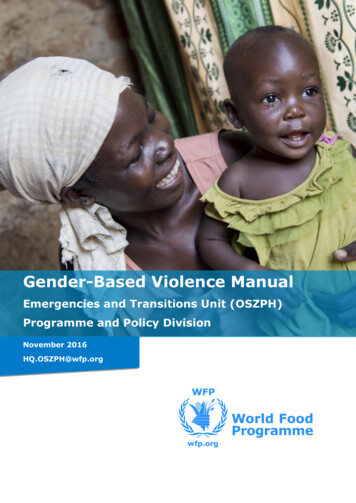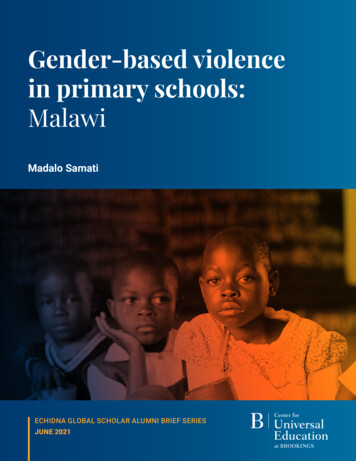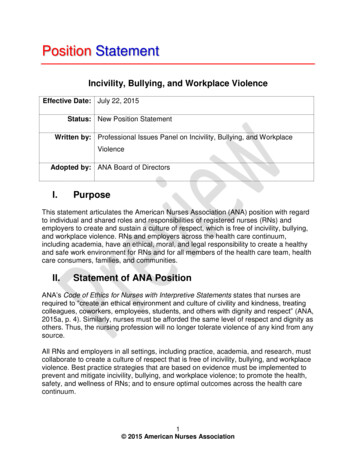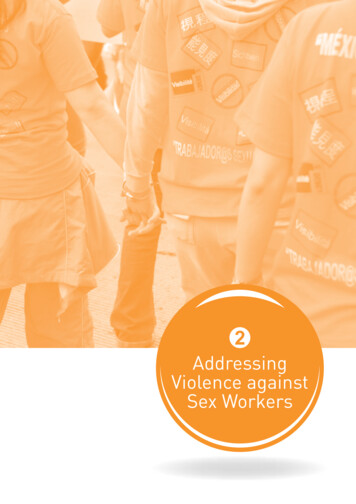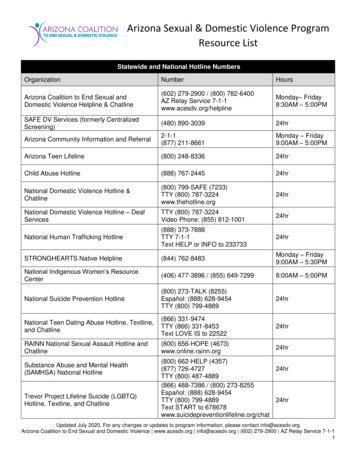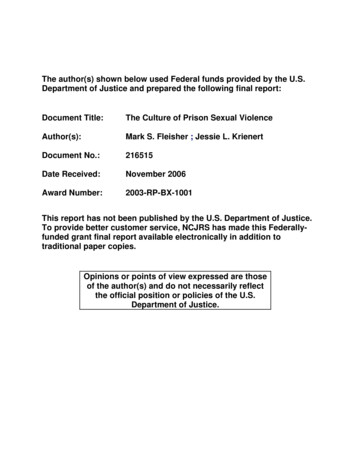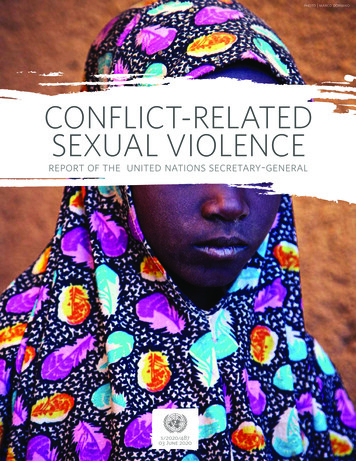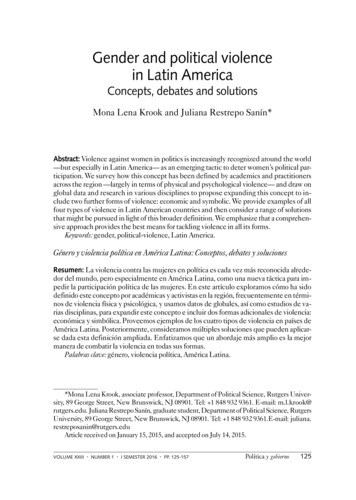
Transcription
Gender and political violencein Latin AmericaConcepts, debates and solutionsMona Lena Krook and Juliana Restrepo Sanín*Abstract: Violence against women in politics is increasingly recognized around the world—but especially in Latin America— as an emerging tactic to deter women’s political participation. We survey how this concept has been defined by academics and practitionersacross the region —largely in terms of physical and psychological violence— and draw onglobal data and research in various disciplines to propose expanding this concept to include two further forms of violence: economic and symbolic. We provide examples of allfour types of violence in Latin American countries and then consider a range of solutionsthat might be pursued in light of this broader definition. We emphasize that a comprehensive approach provides the best means for tackling violence in all its forms.Keywords: gender, political-violence, Latin America.Género y violencia política en América Latina: Conceptos, debates y solucionesResumen: La violencia contra las mujeres en política es cada vez más reconocida alrededor del mundo, pero especialmente en América Latina, como una nueva táctica para impedir la participación política de las mujeres. En este artículo exploramos cómo ha sidodefinido este concepto por académicas y activistas en la región, frecuentemente en términos de violencia física y psicológica, y usamos datos de globales, así como estudios de varias disciplinas, para expandir este concepto e incluir dos formas adicionales de violencia:económica y simbólica. Proveemos ejemplos de los cuatro tipos de violencia en países deAmérica Latina. Posteriormente, consideramos múltiples soluciones que pueden aplicarse dada esta definición ampliada. Enfatizamos que un abordaje más amplio es la mejormanera de combatir la violencia en todas sus formas.Palabras clave: género, violencia política, América Latina.*Mona Lena Krook, associate professor, Department of Political Science, Rutgers University, 89 George Street, New Brunswick, NJ 08901. Tel: 1 848 932 9361. E-mail: m.l.krook@rutgers.edu. Juliana Restrepo Sanín, graduate student, Department of Political Science, RutgersUniversity, 89 George Street, New Brunswick, NJ 08901. Tel: 1 848 932 9361.E-mail: juliana.restreposanin@rutgers.eduArticle received on January 15, 2015, and accepted on July 14, 2015.volume xXIiI·number 1·I semester 2016·PP. 125-157Política y gobierno125
Mona Lena Krook and Juliana Restrepo SanínOver the last twenty years, the world has witnessed major shifts towardsgreater gender equality in elected office, driven by global and grassroots campaigns associating gender balance in political life with a host ofpositive implications for democracy and society at large (Krook, 2009;Krook and True, 2012). More equal representation, supporters argue, is notonly just —women form half the population and thus should occupy half ofall decision-making positions— but also enhances the likelihood that allcitizens’ concerns will be reflected in public policy, in turn sparking greatercitizen engagement with and confidence in political institutions (Phillips,1995; Schwindt-Bayer and Mishler, 2005). These messages have resonatedin the vast majority of countries, with a variety of measures —most notably,gender quotas— being adopted with the aim of electing more women(Krook, 2009).There is growing awareness, however, that strategies like gender quotasdo not fully level the political playing field. The gendered political environments in which they are introduced, for example, can continue to makeit difficult for women to be selected as candidates and to exercise authorityonce elected (Bjarnegård, 2013; Krook and Norris, 2014; Puwar, 2004;Walsh, 2011). Initiatives such as quotas can also trigger various forms ofbacklash and resistance to women’s political integration, ranging from explicit acts of violence and harassment to sexism in media coverage and social media platforms, directed at women as women with the purpose ofleading them to withdraw from political life (Krook, 2015; Krook and Restrepo Sanín, 2014). Such acts pose a serious challenge to democracy whenwomen are actively prevented from carrying out their campaigns or fulfilling their mandates. Electoral processes are thus effectively nullified, becoming subject instead to forces of intimidation and coercion.The problem of “violence against women in politics,” as these backlasheffects have come to be known, has raised growing concern among international non-governmental organizations (ngo) around the world (Bardall,2011; iKnowPolitics, 2007; Inter-Parliamentary Union, 2014; NationalDemocratic Institute, 2014; South Asia Partnership International, 2006;usaid, 2013). This phenomenon, however, has thus far received the greatest attention in Latin America, where a host of actors —elected women,journalists, academics, international ngos, and even electoral tribunals—have sought to render the problem visible and combat it through a varietyof strategies to protect women’s right to participate and better ensure theintegrity of the electoral process. As a result, countries in the region provide126Política y gobiernovolume xXIII·number 1·I semester 2016
Gender and political violence in Latin Americamounting evidence of violence against women in politics —and expose awide range of potential solutions, including bills in congress to criminalizethese acts. These experiences have the potential to enrich emerging globaldiscussions, which have not advanced to the same degree in other regions.Yet data from other countries —as well as insights from related academicliteratures— can also inform developments in Latin America, highlightingthe pervasive nature of this problem and lending greater conceptual precision to these debates.We begin in the first section by mapping the “state of the art” across theregion in terms of debates around “political violence and political harassment against women” (violencia política y acoso político hacia las mujeres). Wetrace how activists across Latin America have defined this concept, working inductively from their experiences and observations. We find that theBolivian case, where a long grassroots campaign culminated in legal reformin 2012, was seminal in three respects: giving a name to this phenomenon,highlighting psychological alongside physical forms of abuse, and developing legislation to criminalize these behaviors. In the next three sections, weput these developments in dialogue with global data and research in various academic disciplines in an effort to better theorize what violenceagainst women in politics “is” and, in turn, what steps might be taken toreduce its impact. Attention to concept formation is vital for both scholarsand activists as a means for understanding and analyzing the world in amore systematic way, as well as for devising effective solutions to pressingpolitical problems (Goertz, 2006; Sartori, 1970).We engage with various academic literatures in the second section, first,to distinguish violence against women in politics from related concepts likeelectoral and political violence and violence against women and, second, totheorize why such violence occurs and the significance of the particularforms it takes. In the third section, we incorporate feminist and non-feminist research on violence to argue for an expanded definition of violenceagainst women in politics that renders explicit two further forms of violence —economic and symbolic— as well as inter-relations between different types. We substantiate this revised framework with examples of all fourkinds of violence from various Latin American countries.In the fourth section, we consider the theoretical and practical implications of opting for different definitions. We propose that broadening theconcept to include more dimensions is vital for understanding the nature ofthe issue as well as for devising effective solutions. Indeed, this exercisevolume xXIII·number 1·I semester 2016Política y gobierno127
Mona Lena Krook and Juliana Restrepo Sanínreveals widespread resistance to the full political incorporation of women,both in Latin America and across the world. We conclude by reflecting onwhy violence against women in politics should be a concern for citizens, aswell as the larger academic community. Rather than being dismissed as“normal politics”, we argue, these acts should be understood as efforts toundermine the civil and political rights of women, threatening broaderprospects for inclusion and democracy and respect for human rights in Latin America and beyond.Emerging debates in Latin AmericaViolencia política y acoso político hacia las mujeres describes behaviors that specifically target women as women to leave politics by pressuring them to stepdown as candidates or resign a particular political office. In Latin America,this concept made its first concrete appearance in Bolivia in 2000, whenlocal councilwomen convened at a seminar at the Chamber of Deputies todiscuss reports regarding harassment and violence against women in ruralmunicipalities. Events that ensued from this meeting played a crucial roleacross the region in naming this phenomenon, defining its contours interms of the types of acts constituting political violence and harassment,and privileging legal reform as the primary strategy for combating thisgrowing problem.The Association of Local Councilwomen of Bolivia (Acobol) has beenthe crucial actor in this process. Soon after their first meeting, Acobolgained a commitment in 2001 on the part of Congress to work on legislationto address the issue. A bill was eventually presented during the 2005-2006congressional term, as a legislative initiative of civil society joining localelected women with female parliamentarians and civil society groups(iKnowPolitics, 2007, p. 16). To aid in this work, Acobol developed a reporting process to track cases via a statistical information system. By 2012,the group had assembled more than 4000 claims from elected women,mainly in rural areas with indigenous populations, testifying to the role ofharassment and violence in negatively affecting their political work (Observatorio de Género, 2012, p. 1). The law remained controversial —and indeed, was opposed by some indigenous women who argued that it was alaw against men (and, specifically, their sons) (Cabezas Fernández, 2014)—but it was approved in Congress in 2012 after the high-profile murder oflocal councilwoman Juana Quispe.128Política y gobiernovolume xXIII·number 1·I semester 2016
Gender and political violence in Latin AmericaThe resulting reform, Law 243 against Political Harassment and Violence against Women,1 largely reflects the inductive work of Acobol andother female politicians and activists to name this phenomenon and identify its various manifestations. Law 243 protects female candidates, electedofficials, appointees, and those exercising political functions who confrontefforts to prevent their presence in decision-making positions for reasons ofgender. The law defines “political harassment” as “acts of pressure, persecution, molestation, or threats” and “political violence” as “acts and/orthreats of physical, psychological, or sexual violence”, aimed at shortening,suspending, impeding, or restricting the exercise of a woman’s political position, or inducing a woman, against her will, to commit an act or fail to dosomething related to her political mandate. Article 8 enumerates a long listof behaviors constituting harassment and violence against women in thepolitical realm. Interestingly, while the legislation mentions physical andsexual acts, all of the examples given in this article fall under the heading ofpsychological violence, presumably because there may be less consensusthat these actions constitute acts of “violence.”The behaviors enumerated in Article 8 include imposing, due to genderstereotypes, tasks unrelated to the job itself;2 giving women erroneous orimprecise information leading to the inadequate exercise of their functions; preventing appointed or elected women from attending sessions orother activities involving decision-making; providing false or incompleteinformation to electoral authorities regarding the identity or sex of can didates;3 impeding or restricting a woman’s re-nomination or election whenshe uses her office correctly; restricting a woman’s ability to speak in sessions, committees, or other meetings inherent in her job; restricting or impeding women from assuming office who have been elected through theprocedures of indigenous or Afro-Bolivian groups; imposing unjustifiedsanctions that restrict a woman’s exercise of her political rights; applyingillegal economic sanctions or withholding women’s salaries; divulging personal and private information to force women to resign or request a leave1See full text here: http://www.comunicacion.gob.bo/?q a-politica-hacia-las-mujeres2What is meant by this phrase is not made explicit in the law, but interviews by one co-authorwith women in Latin America indicates that this might include making coffee or performingsecretarial tasks for colleagues.3In previous elections, political parties had attempted to circumvent the gender quota law by“misspelling” the male names on their candidate lists to appear as if they were female.volume xXIII·number 1·I semester 2016Política y gobierno129
Mona Lena Krook and Juliana Restrepo Sanínfrom their positions; spreading false information with the objective of discrediting a woman’s leadership and obtaining her resignation or leave of herposition; forcing women to resign their positions; and obligating electedwomen —through force or intimidation— to sign documents or take decisions against their will.The law recognizes that such acts can be committed by one or morepeople, directly or through third parties, against female candidates andpublic officials as well as members
Palabras clave: género, violencia política, América Latina. *Mona Lena Krook, associate professor, Department of Political Science, Rutgers Univer-sity, 89 George Street, New Brunswick, NJ 08901. Tel: 1 848 932 9361. E-mail: m.l.krook@ rutgers.edu. Juliana Restrepo Sanín, graduate student, Department of Political Science, Rutgers

